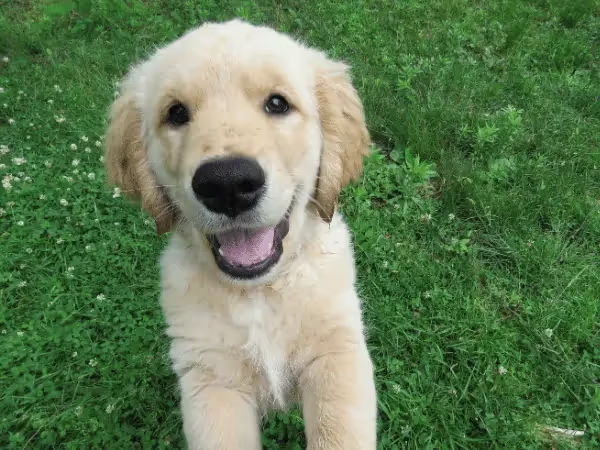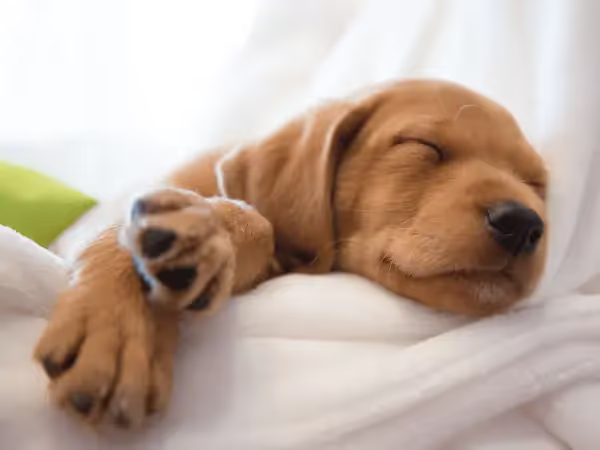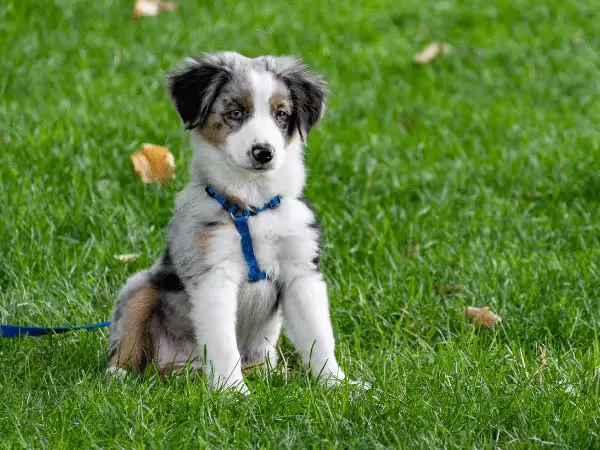Potty training a puppy is one of the first big lessons your pup will learn. Done right, it sets the stage for a lifetime of good habits. It is advisable to start as soon as possible after the puppy reaches 8 weeks of age. This Sploot Vets guide on how to potty train a puppy covers everything you need to know regarding puppy potty training, covering the best timing, techniques, and more!
Overview:
- Start potty training your puppy at 8 to 12 weeks of age; it’s best to start as soon as possible to build lasting good habits.
- Potty training a puppy can be enhanced with crate training, as well as pee pad training in certain instances.
- Even with adherence to the steps on how to potty train a puppy, medical conditions (e.g., UTIs, digestive issues) may interfere with potty training.
I. The Puppy Potty Training Timeline
When to Start Puppy Potty Training
We recommend starting potty training your puppy as soon as they get home, as long as they are at least 8 to 12 weeks of age. This is the time when most puppies develop bladder control, making training more efficient and effective.
Note: Bladder control improves over time. The maximum hours that a puppy can hold their bladder is generally equal to their age in months + 1. For example, a 2-month-old puppy can generally hold it for 3 hours. However, this is the upper limit. Therefore, potty breaks can be scheduled at more frequent intervals to avoid accidents, as we’ll discuss further in this guide.
How Long Does It Take For A Puppy To Be Potty Trained?
Realistically, it takes around 4 to 6 months to potty train a puppy. Most puppies will not get potty training perfect during the first few months, but they will generally show progress with time.
However, potty training success can be affected by factors like consistency, breed predispositions, the puppy’s development, and medical issues (e.g., UTIs, digestive issues) that make potty training challenging.
At What Age Should A Puppy Be Fully Potty Trained?
Most puppies are fully potty trained, with minimal to no accidents, at around 9 months of age.

II. What Is The Fastest Way To Potty Train A Puppy? [Effective Tips]
Effective puppy potty training works on the principle of creating consistent habits and positively reinforcing them.
1. Take Your Puppy Outside Regularly
By regularly taking your puppy outside (as well as after meals and naps), you show them that going potty needs to be done outside. You will also be able to establish where they can go, whether that’s the backyard, a nearby grassy area, or so on. In a later section, we will cover the different times that a puppy needs to go on a potty break and why they’re important.
2. Learn the Signs That a Puppy Needs to Go
Even with planned potty breaks, your puppy may still need to go at different times. By catching these moments, you can promptly bring them to the designated spot and help reinforce the habit of relieving themselves outside. This may be particularly helpful during the beginning stages of puppy potty training.
You can also take note of the time, so that you can personalize your puppy’s potty schedule. This helps you anticipate potty breaks for your dog.
Watch out for the following signs:
- Whining or barking
- Walking in circles or pacing the room
- Moving nervously or trembling
- Sniffing the area
- Scratching at the door or sitting by the door
3. Use a Voice Command or Cue
Using a voice command or cue is important because it creates a clear, consistent signal that helps your puppy understand exactly what you want them to do. Over time, they associate the cue (like a cheerful “Go potty!”) with the action of relieving themselves. This makes potty breaks more efficient, even in new or distracting environments later on.
4. Use Positive Reinforcement
Positive reinforcement is all about rewarding good behavior. It is one of the most effective ways to train puppies. When it comes to potty training, when your puppy gets it right, you reward them with treats and praise, making them more likely to repeat the behavior.
You can also use a clicker. Once your puppy is done going potty, use the clicker and immediately provide treats and praise afterwards. The clicker helps the puppy pinpoint the behavior that is being rewarded.
5. Consider Using the 10-10-10 Rule for Puppy Potty Training
Pet parents may wonder how long potty breaks should be and whether or not they need to stay with their puppy. To answer this, the 10-10-10 Rule was created. So, what is the 10-10-10 rule for puppies? This framework helps provide structure for puppy potty breaks. It stands for:
- 10 minutes in the yard or designated spot
- 10 feet of potty area, not a strict spot
- And 10 minutes of supervision (stay with your puppy while they go).

III. Establishing a Puppy Potty Training Schedule
A predictable daily schedule is crucial for potty training. There are several key times in the day when you should make sure to take your dog out during potty training.
1. In the Morning
Right after waking up, you can take your puppy outside to go potty. Avoid waiting too long, as this can increase the chances of an accident.
Note: Puppies generally sleep for 7 hours.
2. Regular Potty Breaks [Every Few Hours Based on Their Age]
Puppies need to be taken outside regularly so they can relieve themselves. The timeframe varies depending on a puppy’s bladder control, which changes based on their age.
A great technique for identifying how long a puppy can hold it is to consider their age in months. Per every month of age, puppies can generally hold it for one hour. Here are some examples:
- 2 months old = 2 hours
- 3 months old = 3 hours
- 4 months old = 4 hours
- And so on.
3. After Meals or Drinking Plenty of Water
Aside from the set interval for potty breaks, it’s also important to bring your puppy out after their meal to prevent accidents. Many pet parents wonder: “How long after eating does a puppy poop?” Puppies need to go around 15 to 30 minutes after their meal. The same timeframe applies when they drink a lot of water.
With that said, Sploot veterinarian, Dr. Sylvia Berns, reminds pet parents: “It is important to keep fresh water available at all times for your puppy; do NOT restrict their water intake solely because of accidents or needing to go to the bathroom, as water restriction can lead to unfavorable metabolic changes and can adversely impact your puppy’s urinary health.”
4. After Naps
Naps help support a puppy’s rapid growth and development. If a puppy’s nap coincides with their regular potty break, AVOID waking up the puppy. Instead, allow your puppy to finish their nap. When they wake up, they’d probably need to go for a potty break. Readjust their scheduled potty breaks accordingly.
5. Before Bed
Take your puppy to go potty before bed to help them empty their bladder and reduce the chances of nighttime accidents. This simple habit sets them up for a more comfortable night and teaches them to associate going potty with winding down for sleep.
6. At Night
If your puppy wakes up during the night, wanting to go potty, stay calm and keep the potty break quick and low-stimulus. Turn on as few lights as possible and do not engage in any snacks or playtime. This will encourage your puppy to sleep till morning.
Note: If going outside in the middle of the night is not an option, you can train your puppy to use pee pads or indoor dog turf instead.

IV. When Potty Accidents Happen: What to Do
Accidents can and will happen. Your puppy is still learning, and there are times when bladder or bowel control may be more challenging for them. Therefore, one of the most important steps in how to potty train a puppy is responding appropriately to potty training mistakes.
1. Take Your Puppy Outside Anyway
If your pup makes a mess in the house, immediately take them outside to their designated potty area, even if they don't need to go anymore. This will help your pup associate the act of using the bathroom with going outside.
If the puppy is just about to go or isn’t finished going, take them outside so they can finish going potty outside. This helps reinforce good potty habits.
2. Avoid Punishing Your Puppy
Don't yell or aggressively scold your pet for making a mess, as this can make them fearful of going to the bathroom.
3. Clean the Mess with Puppy-Friendly Cleaner
We recommend cleaning up the indoor mess (if any) as quickly as possible so your puppy doesn't associate that area with using the bathroom. Use pet-friendly enzymatic cleaners because they break down odor-causing proteins, removing smells that might encourage repeat accidents in the same spot.
Avoid harsh chemical cleaners, especially those with ammonia, as their scent can mimic urine and confuse your puppy. Additionally, ammonia fumes can be harmful to a puppy’s sensitive respiratory system, so it’s best to avoid them entirely.
4. Consider Medical Obstacles
Health issues like urinary tract infections (UTIs) and digestive upset can significantly impact potty training success. Puppies with UTIs may experience frequent urges to urinate, discomfort, or even painful urination, leading to more accidents despite their best efforts. Similarly, digestive issues like diarrhea or upset stomachs can make it difficult for puppies to control their bowels, resulting in unexpected messes and setbacks in training.
If you notice frequent accidents, straining, whining during potty breaks, or sudden changes in bathroom habits, it’s important to consult a veterinarian right away.
V. Potty Training & Crate Training
Crate training is all about helping puppies associate their crate with safety and comfort. It is also advisable for puppies to sleep inside crates.
Proper crate training helps puppies during potty training by tapping into their natural instinct to keep their sleeping area clean, which encourages them to “hold it” until they’re let out.
A properly sized crate teaches them bladder and bowel control by creating clear boundaries between rest and potty time. It also establishes a safe, cozy space where they can relax and feel secure, reducing anxiety and promoting healthy routines.
Dr. Berns shared some guidelines on choosing a properly-sized crate: “To help with potty training, the crate should generally be only as big as the puppy needs to comfortably stand and do a full turn. (Pet parents can use dividers if they’ve already purchased a large crate.) If there is too much room in the crate, the puppy might eliminate in one corner and stay in the other, pushing their potty training back further.”

VI. Potty Training with Pee Pads
Puppy pee pads can serve as a substitute potty area when frequent outdoor trips aren’t possible, such as for apartment living, during bad weather, or when a puppy isn’t fully vaccinated.
Placing pee pads in a designated spot teaches your puppy where it’s appropriate to relieve themselves indoors, helping prevent random accidents around the house. While they’re convenient, it’s important to keep the area consistent and gradually transition the pads closer to the door if you plan to eventually move potty habits outside.
Final Thoughts on Potty Training Puppies
If you have further questions, consult a trusted puppy veterinarian. Veterinarians are the best available resource for potty training your puppy. Every pup is a little different, and a veterinarian can help you understand the unique differences that you’ll find with your puppy.
For more information on raising a healthy and confident puppy, check out our FREE resources:
- How to Take Care of a New Puppy 101: The 1st Year →
- How to Socialize a Puppy - with People & Other Dogs→
Puppy Care at Sploot Veterinary Care
Sploot Veterinary Care is a go-to vet clinic for primary care for puppies and dogs of all ages. We also provide urgent care and emergency vet services!
We offer daily appointment availability (including holidays) and extended vet clinic hours, so that we can be here for pet parents when our help is needed the most. We have multiple convenient locations in Denver, Chicago, and Colorado Springs.
Feel free to book an appointment online or through the Sploot Vets app.

Save More on Top-Tier Puppy Care With SplootPack™
Get huge savings on essential vet services for your growing furry friend. The SplootPack™ membership helps you save up to $650+ on essential puppy care.
Get 3 waived puppy exams or check-ups, exclusive discounts for spay/neuter procedures, 10% OFF on all Sploot’s services, and more!






